As Team PetsPaa, we feel that cats are magnificent creatures who offer us joy. We also understand that some cat owners struggle with scratching and destructive behavior. Nevertheless, declawing is not the solution as there are so many cat declawing alternatives present.
Declawing is a harsh and painful practice that should be avoided. In this detailed cat declawing alternatives article, we will look at why cats need their claws as well as cat declawing alternatives.
Table of Contents
Introduction
As PetsPaa, it’s important for us to inform pet owners about alternatives to declawing their cats. Declawing is a controversial procedure that involves removing a cat’s claws surgically.
Declawing may seem to be an easy and effective way to protect humans and furniture from scratch, but it is a painful and disputed treatment. Declawing a cat may cause long term consequences on mental and physical health. It is important for cat lovers to investigate cat declawing alternatives for fulfilling their cat’s natural behavior while also protecting their homes. for fulfilling their cat’s natural behavior while also protecting their homes.
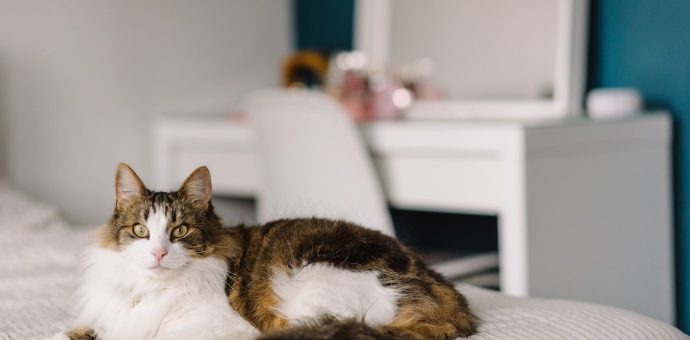
In this cat declawing alternatives article, we will discuss what is declawing, why some cat owners consider declawing. the potential cons of declawing, why cats need their claws and 10 cat declawing alternatives that we recommend to our cat parents. These alternatives range from providing designated scratching surfaces and furniture deterrents to using synthetic nail caps and synthetic facial pheromone spray/diffusers etc.
Cat owners may assist their cats to continue their natural activities while still safeguarding furniture and other home goods by considering these cat declawing alternatives. Cats are an intelligent and social animal who requires mental and physical activity in order to be happy and healthy. These cat declawing alternatives can keep cats happy and healthy while also encouraging a loving and positive bond between pet and owner.
What is Cat Declawing?
Cat declawing, also known as onychectomy, is the surgical removal of a cat’s claws. It entails amputating the complete final bone of each of the cat’s front paw toes. The surgery may also include the removal of the claws on the hind paws in rare situations.
Declawing can cause pain, lameness, and nerve damage. Declawed cats may experience chronic pain and difficulty walking, jumping, and balancing. Declawing can alter your can behavior and makes them aggressive, anxious, and avoidant.
Why do Owners Declaw Cats?
Cat owners dewclaw their cats for a variety of reasons, including:
- Owners declaw cats to protect furniture and prevent scratching people.
- Some landlords require declawing for rental units.
- Some owners see it as responsible cat ownership.
- Unaware of the negative point or consequences of declawing.
- Unaware of cat declawing alternatives.
- Prevent the cat from scratching people, particularly young children.
However, It is important to point out here, these reasons primarily fulfill the owner’s convenience rather than the betterment of the cat.
Cat Declawing Procedure
Declawing is a surgical intervention that can only be done by a registered veterinarian doctor. The last bone of each toe on the cat’s front paws is removed during the operation, which is usually carried out while the patient is under general anesthesia. In some cases, the rear paws’ claws are to be cut out also.
Depending on the process scalpel, laser, or guillotine nail clipper may be used. The cat must be kept indoors after the surgery until the surgical site has fully recovered, which might take two to three weeks or more in some cases.
Read More >> 10 Easy Steps for Kitten Litter Box Training
Cat Declawing Cons
Declawing can have several potential consequences for cats, including:
Pain and discomfort
Declawing is a painful operation that can cause discomfort, suffering, and pain to the cat. In some cases, this pain can last for several weeks or even months after the procedure.
Behavioral issues
Declawing can cause behavioral problems in cats, such as litter box avoidance, aggression and biting.
Health problems
Declawed cats may be more prone to health issues such as arthritis because they are forced to walk differently after the treatment.
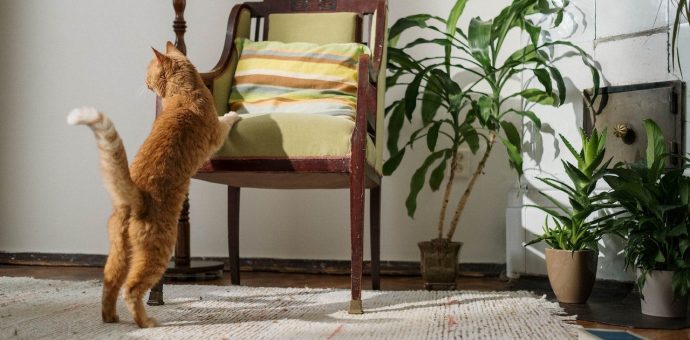
Complications from surgery
Every surgery carries the risk of complications such as infection, bleeding, or anesthetic reactions. Declawing is a risky surgery with serious health effects for the cat.
Emotional distress
Declawing can cause emotional distress for cats, as they are unable to engage in natural behaviors and may feel vulnerable and anxious without their claws for protection.
Inability to defend themselves
Declawed cats are unable to defend themselves against predators or other cats, putting them in danger of harm or death.
Why Do Cats Need Their Claws?
Cats require their claws for a number of reasons. Claws assist cats in climbing, jumping, running, playing, and defending themselves. Claws also assist cats in grooming and marking their territory. Declawing removes an important part of a cat’s anatomy and can cause physical as well as mental issues.
Humane Declawing Alternatives or Cat Declawing Alternatives
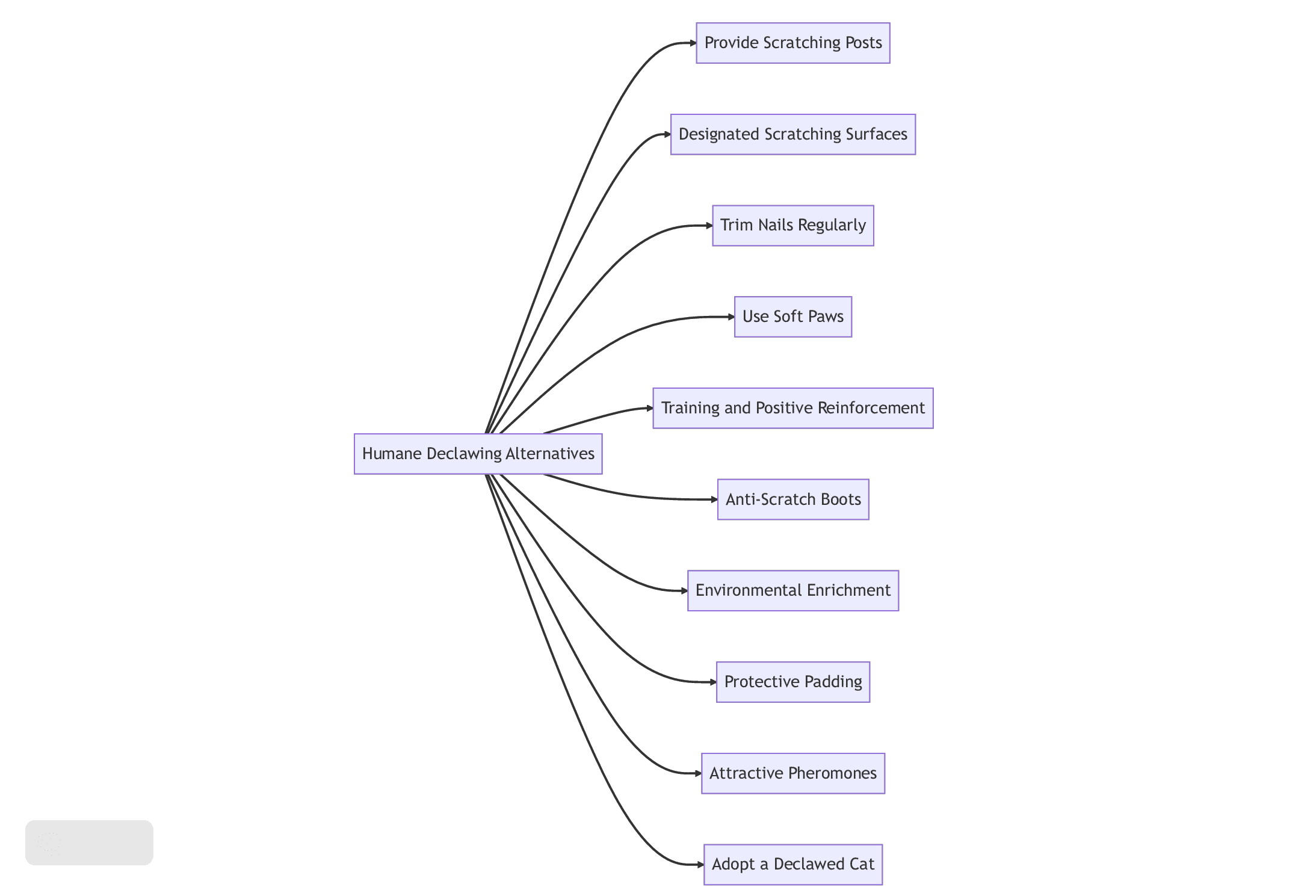
Provide Scratching Posts (1. Cat Declawing Alternatives)
Cats scratching is a normal activity. Placing a scratching post or pad for your cat might help focus its scratching propensity away from your furniture. Put the scratching post wherever your cat has visibility and reward him for using it.
Designated Scratching Surfaces (2. Cat Declawing Alternatives)
Cats have a natural desire to scratch, so providing them with appropriate scratching areas can prevent them from scratching the furniture. Scratching posts, pads, and trees are all excellent choices. Choose surfaces that are both tall enough for your cat to stretch out on and strong enough to support their weight.
Trim Nails Regularly (3. Cat Declawing Alternatives)
Trimming your cat’s nails can help to keep your furniture and carpets in good condition. Trim only the sharp tips of the nails with special cat nail clippers. Avoid cutting the quick, which is the pink area of the nail that contains blood veins. If you’re unclear about how to clip your cat’s nails, ask your veterinarian for advice.
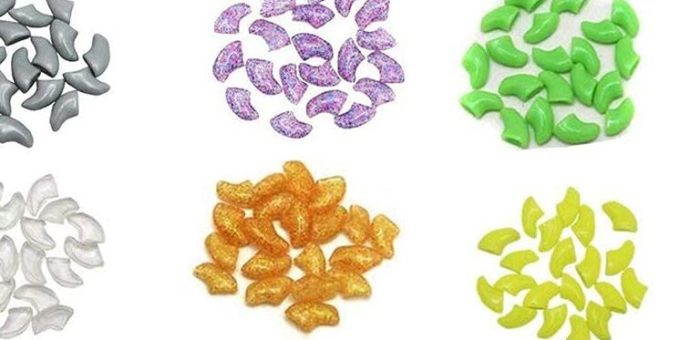
Use Soft Paws (4. Cat Declawing Alternatives)
Soft Paws are nail caps made of vinyl that fit over your cat’s claws. They’re simple to use and available in a range of colors. Soft Paws are safe for your cat and can assist to keep your furniture and carpets in good condition.
Training and Positive Reinforcement (5. Cat Declawing Alternatives)
Positive reinforcement training methods can reduce the risk of destructive behavior in cats. Use treats and praise to reward your cat for positive behavior, such as using the scratching post or pad. Reward the desirable behaviors as soon as it happens. Avoid hurting your cat since it may cause fear and anxiety.
Anti-Scratch Boots (6. Cat Declawing Alternatives)
Anti-scratch boots are specially designed to cover a cat’s claws and safeguard furniture and other things from scratch. They are an excellent alternative to declawing since they let cats behave naturally.
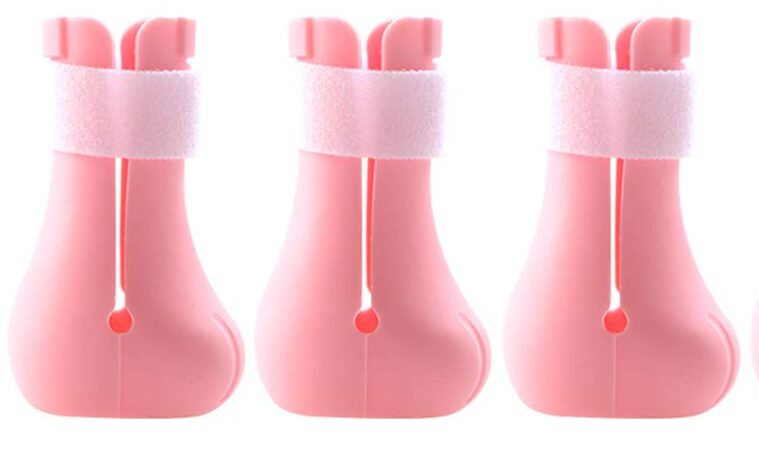
Environmental Enrichment (7. Cat Declawing Alternatives)
Toys, climbing structures, and other types of enrichment can help cats satisfy their natural instincts while reducing the probability of destructive behavior. Bored or under-stimulated cats are more likely to scratch furniture and other items.
Protective Padding (8. Cat Declawing Alternatives)
If your cat has a favorite piece of furniture that they like to scratch normally. Cover it with a protective covering like a blanket or towel.
To stop cats from scratching furniture, use double-sided tape, aluminum foil, or other unpleasant materials. Citrus-scented cotton balls can also be placed near the areas you want to safeguard, as most cats dislike the smell of citrus.
Attractive Pheromones (9. Cat Declawing Alternatives)
Cats communicate through pheromones. Certain synthetic pheromones are used to reduce the destructive behavior of cats, such as Feliway. Feliways is used sprayed on furniture and other things to make them less attractive to cats.
Adopt a Declawed Cat (10. Cat Declawing Alternatives)
If you are worried about damage to furniture and other items, consider adopting a declawed cat. These cats can still be loving and loyal companions.
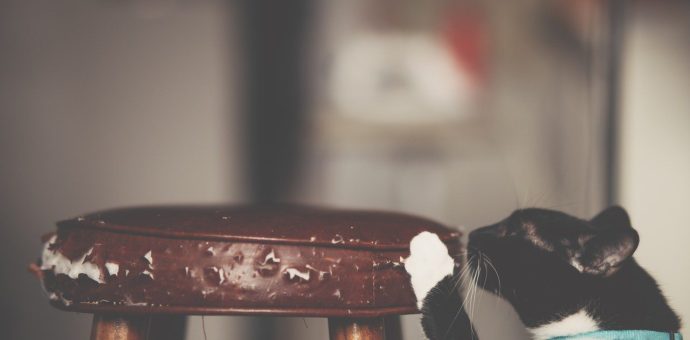
Conclusion
We at PetsPaa strongly advise you to explore these cat declawing alternatives. Declawing is an uncomfortable and painful procedure for cats. It also has a negative impact on the behavior, health, and betterment of cats. You may offer your cat a suitable environment for their natural behavior while still safeguarding your property by applying these alternatives.
Remember, cats are intelligent and social creatures that require mental and physical stimulation to thrive. Prioritize the well being of your furry friend by choosing humane alternatives to declawing.
One option is to provide your cat with a scratching post and redirect their scratching behavior onto appropriate surfaces. Frequent nail trimming and positive reinforcement training can also help. Another alternative is to use Soft Paws, which are nail caps that can be applied to your cat’s claws.
At last, declawing is a controversial procedure that can cause cats pain and discomfort. As a responsible pet owner, you should look into cat declawing alternatives to keep your cat happy and healthy as well as protect your furniture and other household goods also.
"Be Petspaa, Do PetsPaa"
Read More...
- Declawing Dogs: Is It Worth the Risk? A Comprehensive Guide
- Healthy Cat Signs: Your ABC Guide to Feline Wellness
- 10 Easy Steps for Kitten Litter Box Training
- Basics of Cat Grooming: Essential Tips for a Happy Feline
- Top 10 Benefits of Owning a Pet: A Detailed Insight
- 10 Most Common Dog Behavior Issues: A Detailed Guide
- Labrador Retrievers Exclusive: The Ultimate Resource for Dog Lovers






